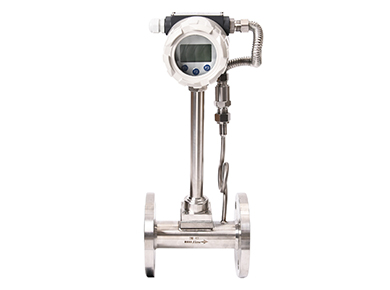A vortex flow meter is an instrument used to measure the flow of a fluid in a pipeline. It is a type of velocity flow meter whose operating principle is based on the physical phenomenon of the Kármán vortex street. It is widely used in industrial process control, especially in steam measurement, because of its simple structure, no moving parts, a variety of measurable media (liquids, gases, steam), wide range, moderate accuracy and other advantages.

The sensor and vortex generator are located completely inside the pipe and are less affected by local flow field distortions, providing higher measurement accuracy and better stability.

Particularly suitable for measuring the flow of large-diameter pipes (usually DN200 or more). No need to cut the pipe, low installation cost. Insertion depth is adjustable.
How does Vortex Street flow meter work?
Simply put, vortex shedding flow meter is through the pipeline to create an artificial obstacle, so that the fluid flow through the regular vortex, and then through the measurement of the frequency of these vortices to deduce the fluid flow rate and flow rate of a kind of instrument.
Work process
- Setting obstacles: Inside the pipe of the flowmeter, placed perpendicular to the direction of fluid flow, a specially shaped column, known as the “vortex generator body” (Bluff body or Shedder bar).
- Generate vortex: When the fluid flows through the vortex generator, due to fluid viscosity and inertia, will be generated downstream of the body on both sides of the alternating two rotating in the opposite direction, the arrangement of regular vortex. This is like a flagpole in the wind that causes the air to vortex. This series of vortices is called a “Kamen vortex”.
- Measurement of vortex frequency: Over a range of flow velocities (i.e., over a range of Reynolds numbers), the frequency of these vortices is proportional to the average velocity of the fluid flow. The faster the flow speed, the higher the frequency of the vortices.
- Detection and Calculation: The flow meter is equipped with internal sensors (e.g. piezoelectric crystals, capacitive sensors, etc.), which are used to detect the periodic changes in local pressure, velocity or temperature caused by the generation of these vortices, and thus to obtain the frequency of the vortex.
- Output flow: The electronic part of the instrument (transmitter) converts the measured frequency signal into a standard signal (e.g. 4-20mA current signal, pulse signal or digital communication signal) that is proportional to the volume flow rate. The frequency allows you to calculate the fluid velocity and multiply it by the cross-sectional area of the pipe to get the instantaneous volume flow rate.
Advantages
- Simple structure, no moving parts: This makes it very robust and reliable, not easy to wear or jam, less maintenance needs, longer service life.
- Wide range of media: Can be used to measure the flow of liquids, gases, and steam (including saturated and superheated steam), and is highly versatile.
- Wide Turndown Ratio: Usually up to 10:1 or even higher, meaning it can maintain good measurement accuracy over a wide flow range.
- Good output signal linearity: the output frequency signal and the volume flow of fluid into a good linear relationship, easy signal processing and system integration.
- Moderate accuracy: Accuracy (typically in the range of ±0.5% to ±2%) is adequate for many industrial process control applications.
- Low pressure loss: vortex flowmeters cause less permanent pressure loss than throttled differential pressure flowmeters, such as orifice plates, which contributes to energy savings.
- Insensitive to changes in fluid parameters: within a certain range, the measurement results are less affected by changes in fluid density, pressure, temperature, viscosity and other parameters.
- Resistant to high, low temperature and high pressure: different materials can be used to manufacture, can adapt to a wide range of temperature and pressure.
Applications
- Chemical and petrochemical industry: for process fluid monitoring and utility (steam, water, gas) metering.
- Power industry: for steam metering, cooling water monitoring, flue gas emissions monitoring (as an auxiliary means).
- Food and beverage industry: mainly used for utility parts, such as steam, water, compressed air measurement.
- Pharmaceutical industry: the same mostly used in public works, for direct contact with pharmaceutical fluids need to choose a sanitary design.
- Metallurgy and iron and steel industry: cooling water, industrial gas, oxygen, compressed air measurement.
- Paper industry: steam, water, air and other measurement.
- Heating, ventilation and air conditioning (HVAC) and building energy management: chilled water, hot water, steam metering.
